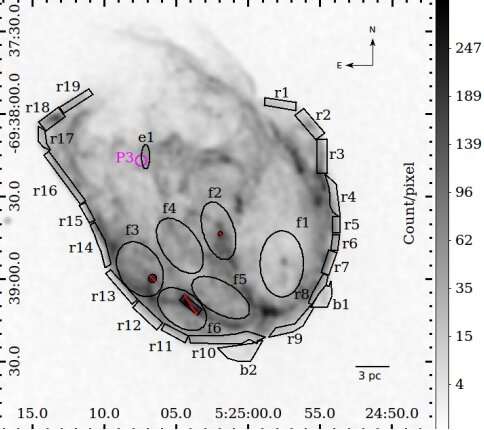Chandra ACIS-S image of counts per pixel in N132D in the 0.35 − 7.0 keV band with x and y axes showing the Right Ascension (RA) and Declination (Dec), respectively. Credit: Sharda et al., 2020.
Researchers from Harvard-Smithsonian Center for Astrophysics (CfA) have conducted detailed spectroscopy of N132D—an X-ray bright supernova remnant (SNR) in the Large Magellanic Cloud (LMC). Results of the study, presented in a paper published April 15 on the arXiv pre-print server, provide important information about the chemical composition of this SNR and shed more light on its origin.
SNRs are diffuse, expanding structures resulting from a supernova explosion. They contain ejected material expanding from the explosion and other interstellar material that has been swept up by the passage of the shockwave from the exploded star.
Studies of supernova remnants are important for astronomers as they play a key role in the evolution of galaxies, dispersing the heavy elements made in the supernova explosion into the interstellar medium (ISM) and providing the energy needed for heating up the ISM. SNRs are also believed to be responsible for the acceleration of galactic cosmic rays.
With an X-ray luminosity at a level of about 30 undecillion erg/s, the Magellanic cloud supernova remnant (MCSNR) J0525-6938, or N132D for short, is the X-ray brightest SNR in LMC. Although many studies of this SNR has been performed, the nature of its progenitor is still uncertain.
To resolve the uncertainties, a team of astronomers led by Piyush Sharda of CfA has carried out a full spectral analysis of the archival data from NASA's Chandra X-ray Observatory. Such analysis of Chandra data regarding N132D has not been performed yet, and the researchers hoped that it could disclose essential information about chemical composition of this SNR and its origin.
"In this work, we have presented spatially resolved X-ray spectroscopy of N132D, the brightest SNR in the LMC, based on archival Chandra observations," the paper reads.
The study calculated the mean local (LMC's environment) abundances of oxygen, neon, magnesium, silicon, sulfur and iron. The results show that oxygen and sulfur abundances are enhanced on the north-western and north-eastern rim of N132D, respectively. Moreover, a faint blob protruding outside the western rim exhibits enhanced abundance of oxygen, what suggests that it could be an oxygen-rich ejecta clump.
By analyzing Chandra data the astronomers found the iron K complex emission in N132D is distributed largely across its southern half and is not located in a single feature. It is assumed that a silicon-rich relatively hot plasma (above 1.5 keV) is behind this emission.
The astronomers estimated that mass of the progenitor of N132D should be around 15 solar masses and concluded that this SNR is a result of a core-collapse supernova.
"Our analysis leads us to conclude that SNR N132D probably resulted from the core-collapse of an intermediate mass progenitor, in a cavity in the CSM [circumstellar medium] created by pre-supernova winds," the researchers wrote in the paper.
More information: Spatially Resolved Chandra Spectroscopy of the Large Magellanic Cloud Supernova Remnant N132D, arXiv:2004.07366 [astro-ph.HE] arxiv.org/abs/2004.07366
Journal information: arXiv
© 2020 Science X Network
























